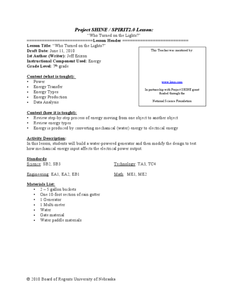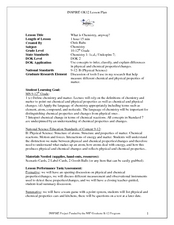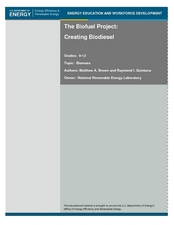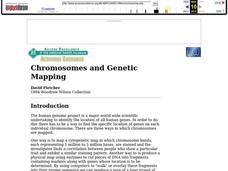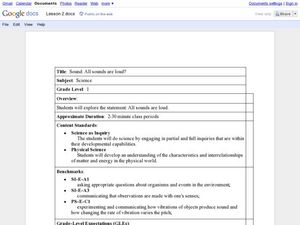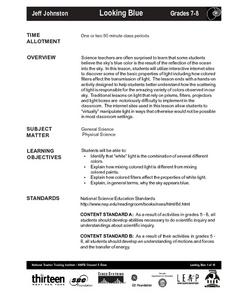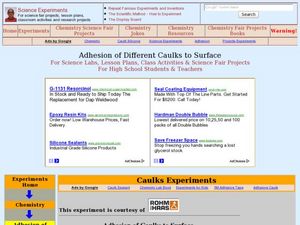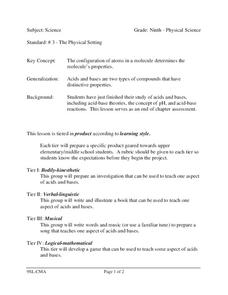Curated OER
Who Turned on the Lights?
Seventh graders discuss how energy is transformed from one form to another. In this physics lesson, 7th graders design and build their own hydro generator. They identify the factors that affect its energy production.
EngageNY
TASC Transition Curriculum: Workshop 9
Here's a workshop for teachers that rocks the academic world! Using earthquakes as a medium for instruction, educators learn about crosscutting engineering with science. Fun, hands-on, collaborative exercises encourage participants to...
Curated OER
Motion and Force
This physics PowerPoint defines the concepts of motion and force. The slideshow consists of an explanation on how motion and force work and give students the chance to demonstrate motion and force through an experiment. The directions...
Curated OER
Light
Light is such a fascinating subject. This lesson does a great job of illuminating the mysteries of light for your young scientists. A series of demonstrations which are explained in the plan should help your charges to understand how...
Curated OER
Color
An interesting set of details about the light spectrum, these slides explain how objects reflect and absorb light to affect how they appear to the human eye. The differences in mixing lights or pigments is explained and some everyday...
Curated OER
What Is Chemistry, Anyway?
Students differentiate physical and chemical change. In this chemistry lesson, students list examples of those changes. They apply what they learned in a Jeopardy style team game.
Curated OER
Newton’s Laws of Motion
Eighth graders explore the three laws of motion. In this physics lesson, 8th graders observe teacher demonstration and explain what happened in terms of Newton's Laws. They complete worksheet at the end of the lesson.
Curated OER
FLY HIGH!!!
Students create their own bird study in their own schoolyard using the scientific method (see Testing a Hypothesis in Join the Project). Students do research in the library, at a local college, or on the Internet to determine the...
Curated OER
The Bio-fuel Project: Creating Bio-diesel
Students investigate bio-fuel. In this investigative lesson, students create bio-fuel from vegetable oil waste. Students will analyze, predict, collect and synthesize data from their experiments with bio-fuel.
Curated OER
Chromosomes and Genetic Mapping
Young scholars are introduced to mapping by crossover frequency. Genes travel as packaged trains on chromosomes. They use this experiment, genetic mapping assignment, that allow students to quickly complete the assignment and yet...
Curated OER
Newton's Second Law of Motion with Balance Toys
Students discuss acceleration and deceleration and participate in brief demonstrations of the Second Law of Motion. They apply the law to a metal balance toy and a plastic balance toy by applying the same force then with different forces.
Curated OER
By Bernoulli, Where's Gravity?
Students observe a 1/4 inch by 2 inch piece of paper that is held vertically downward under the bottom lip, noting that the paper is pulled down by gravity. They predict what happens to the paper if air is blown out. After air is blown,...
Curated OER
Energy Transformation with Balance Toys
Students explore and identify the concepts of potential and kinetic energy. They define kinetic and potential energy and discuss examples of each. Students then play a game involving balance toys, demonstrating both kinetic and potential...
Curated OER
Identifying Acids and Bases
Sixth graders observe the physical and chemical change that can occur in an acid and a base. In this acids and bases lesson plan, 6th graders use cabbage juice to identify, compare, and contrast acids and bases.
Curated OER
Sound: Are All Sounds Loud?
First graders explore physics by utilizing education software. In this sound properties lesson, 1st graders discuss the different sounds associated with different materials and perform an object dropping experiment in class....
Curated OER
The Squeeze is On
Young scholars investigate the force of compression and how it acts on structural components through a hands-on group project. They use everyday products such as paper, toothpicks, and tape to construct a structure that will support the...
Curated OER
The Oceanographic Yo-Yo
Students examine how oceanographers use chemical and physical parameters of seawater to locate hydrothermal vents. In this ocean lesson students complete an activity and worksheets.
Curated OER
Make a Sound Viewer
Students see, and thus better understand, the vibrations that sound makes through this simple project.
Curated OER
Looking Blue
Young scholars participate in a research project that is exclusively using the internet. The author states that traditional labs are hard to conduct for a light lab. This one uses the internet with the intention that students can...
Curated OER
Corrosion/Plating/Electrolysis
Students familiarize themselves with half cell reactions, potential circuits, etc. They participate in a lab that includes a worksheet that guides them through an inquiry pertaining to the content. They complete a series of questions...
Curated OER
Children's Literature Across the Curriculum Ideas-The Gadget War
Students read The Gadget War by Betsy Duffey. They complete a variety of cross-curricular activities surrounding inventors and inventions. Included are reading, art, math, science, writing, social studies, and library connections.
Curated OER
Adhesion of Caulks to Surface - Testing Product Quality
Students investigate quality products. In this Physical Science lesson plan, students will test three different types of caulking. The students are looking for the caulk with the best adhesion after two days of curing.
Curated OER
The Physical Setting
Ninth graders study the configuration of atoms in molecules to see that it determines the molecule's properties. In this chemistry lesson plan students divide into groups and complete their assigned task.
Rochester Institute of Technology
Molecules and Fuel Cell Technology
A fuel cell is where the jailer keeps gas guzzlers. Scholars review chemical reactions, chemical bonds, and chemical structure in order to apply these concepts. Participants construct fuel cell kits, using electrolysis to run the car and...
